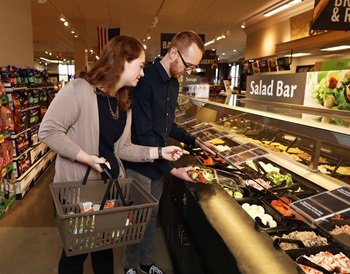By: Rick Stein, Vice President, Fresh Foods, Food Marketing Institute

The home-cooked meal has been the heart of food retail for generations. Yet for many busy families, such meals are not always realistic. A recent FMI study, Power of Foodservice at Retail, finds the average household foregoes a home-cooked dinner about two times a week. That means they either opt to go out to a restaurant, pick-up something to take home or have a meal delivered. Food retailers recognize this trend and responded to a 3.6 percent dollar growth in foodservice by allocating additional space and more staff resources.
Still, there is plenty of unrealized opportunity in those two dinners each week that are not prepared at home. As FMI has learned from previous research, there are two scenarios that often drive the consumers to not prepare dinner at home: a lack of time and not being in the mood to cook. When shoppers are under time constraints to get dinner on the table, they are most likely to prepare an easy meal that takes little time/effort (52 percent). But if they decide to have someone else do the preparation entirely, they are twice as likely to eat out, pick up or get delivery from a restaurant than they are to pick up foodservice or eat in-store.
When they’re not in the mood to cook, more than two out of three shoppers (69 percent) said restaurants were their first choice. And, among those who chose restaurants, two-thirds (68 percent) said just did not think about grocery foodservice as an option. And even though many shoppers make multiple visits to their primary store each week, they only take advantage of grocery foodservice options once every three weeks. Shoppers share that price, speed and nutritional value of what is available also play a factor in their decision making.
The Power of Food Service at Retail report offers a number of findings to increase awareness of foodservice and continue the growth of foodservice:
- Focus on conversion. While visiting the store multiple times/week, shoppers buy grocery deli prepared only every three weeks.
- Strive to be top of mind. When in a rush or not in the mood to cook, shoppers are twice as likely to buy from restaurants.
- Leverage technology to improve visibility and awareness of foodservice as a viable restaurant alternative.
- Maximize your share of market. Half of shoppers purchase grocery deli prepared at outlets beyond their primary store.
- Connect with shoppers. Email and text are the shopper-preferred methods of outreach to learn about deli promotions.
- Provide options for speed-focused shoppers.
- Provide options for nutrition-focused shoppers who deemphasize price and speed, but value customization.
See the FMI recorded webinar that explores the Power of Foodservice at Retail in more detail. For the full Power of Foodservice at Retail report and more FMI research on fresh foods, visit www.FMI.org/FreshFoods.


 Industry Topics address your specific area of expertise with resources, reports, events and more.
Industry Topics address your specific area of expertise with resources, reports, events and more.
 Our Research covers consumer behavior and retail operation benchmarks so you can make informed business decisions.
Our Research covers consumer behavior and retail operation benchmarks so you can make informed business decisions.
 Events and Education including online and in-person help you advance your food retail career.
Events and Education including online and in-person help you advance your food retail career.
 Food Safety training, resources and guidance that help you create a company food safety culture.
Food Safety training, resources and guidance that help you create a company food safety culture.
 Government Affairs work — federal and state — on the latest food industry policy, regulatory and legislative issues.
Government Affairs work — federal and state — on the latest food industry policy, regulatory and legislative issues.
 Get Involved. From industry awards to newsletters and committees, these resources help you take advantage of your membership.
Get Involved. From industry awards to newsletters and committees, these resources help you take advantage of your membership.
 Best practices, guidance documents, infographics, signage and more for the food industry on the COVID-19 pandemic.
Best practices, guidance documents, infographics, signage and more for the food industry on the COVID-19 pandemic.
